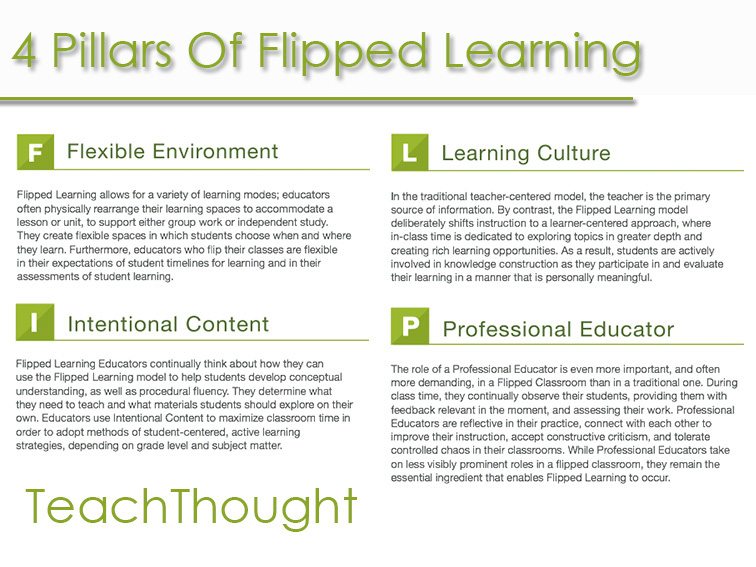4 Pillars & 12 Standards Of Flipped Learning
by Kari M. Arfstrom, Executive Director of the Flipped Learning Network
Flipped Learning Defined
10 Common Misconceptions About The Flipped Classroom, by Kelly Walsh, offered some insight. As did Mike Acedo in his article titled 10 Pros And Cons Of A Flipped Classroom. The Definition Of The Flipped Classroom by TeachThought staff went with a simple definition.
TeachThought has published numerous articles about flipped classroom in the recent past, so it’s only fitting that the Flipped Learning Network™ (FLN) share its latest resource about the definition of Flipped Learning.
The governing board and key leaders of FLN, all experienced flipped educators, released a whitepaper today distinguishing between a Flipped Classroom and Flipped Learning. These terms are not interchangeable. Flipping a class can, but does not necessarily, lead to Flipped Learning. Many teachers may already flip their classes by having students read text outside of class, watch supplemental videos or solve additional problems.
While often defined simplistically as “school work at home and home work at school,” Flipped Learning is an approach that allows teachers to implement a methodology, or various methodologies, in their classrooms. To counter some of the misconceptions about this term, Flipped Learning experts composed a formal definition of “Flipped Learning.” Explicitly defining the term may dispel some of the myths we repeatedly encounter.
4 Pillars & 11 Standards Of Flipped Learning
The Definition of Flipped Learning
Flipped Learning is a pedagogical approach in which direct instruction moves from the group learning space to the individual learning space, and the resulting group space is transformed into a dynamic, interactive learning environment where the educator guides students as they apply concepts and engage creatively in the subject matter.
For educators to engage in Flipped Learning, the following Four Pillars of F-L-I-P must be incorporated into their practice. FLN also created a checklist of 11 indicators for educators as they reflect on their own classroom practices.
 For a downloadable PDF of the definition, Pillars and Indicators, click here.
For a downloadable PDF of the definition, Pillars and Indicators, click here.
Kari M. Arfstrom is the executive director of the Flipped Learning Network. The mission of the Flipped Learning Network is to provide educators with the knowledge, skills and resources to successfully implement Flipped Learning; 4 Pillars & 11 Indicators Of Flipped Learning


